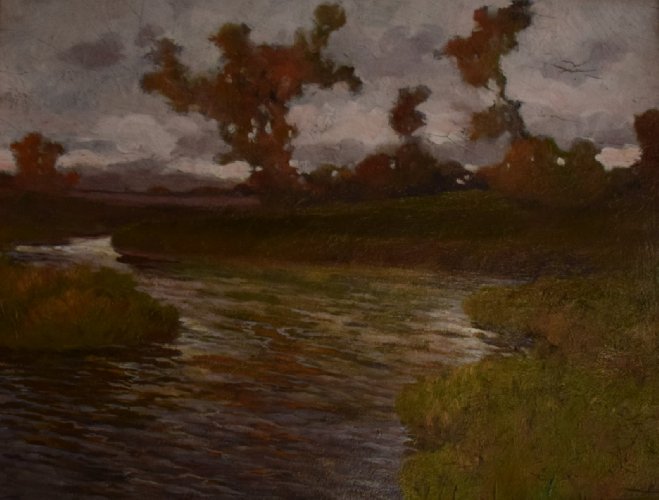Description:
In the presented pictures of Eugeniusz Dąbrowy-Dąbrowskiego (1870-1941) in the Rogaliński Gallery, the self-taught traveler to European countries, the influences of the environment to which he was connected are clearly visible. In the previously mentioned canvas “After the Rain”, painted around 1899, at the end of the artist’s stay in the Bavarian capital, we find a cloudy, dark green Munich color scheme. The mysterious atmosphere achieved with its help is closer to Arnold Böcklin’s painting than to the decorative, almost synthetic creativity of the symbolists of the turn of the century, under the influence of which the later “Evening” was created.
Description of the painting:
The symbolic connotations of this landscape are achieved primarily through the contrast between the foreground of the river bend or marshland with its delicately rippling riverside vegetation and wrinkled green–violet–brown water and the unsettling, cloudy, impasto–painted gray–white sky with ominously brown riverside trees melting into it. Dąbrowski, who could have come into contact with symbolism during his stay in Paris in 1890–92, probably only became inspired by the paintings of Polish modernists, especially the works of Stanisławski and Wyspiański, after he moved to Krakow in 1900. In the decorative character of “Evening”, one can also find the influence of the applied art he willingly practiced. From 1901, being a member of the “Polish Applied Art” Society, he was involved in designing carpets, posters, illustrations, and furniture, but also in painting walls, which he often decorated the places he visited in Krakow, including the confectionery in the Cloth Hall and the restaurant hall in the Old Theater. He also practiced graphics, documented by the five lost, originally located in the Gallery of Colorful Lithographs from 1906, purchased by Raczyński in the Society of Friends of Fine Arts in Krakow. They are known from the artist’s portfolio “Autolitographs”, issued a year later, and analogous lithographs from the National Museum in Warsaw, perhaps identical with those from Rogalin.


